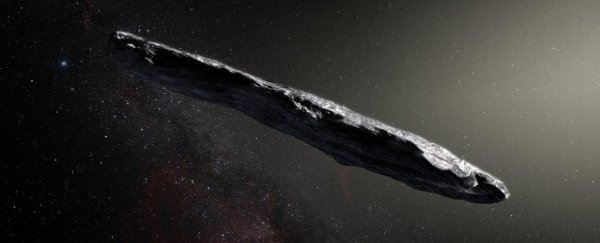Interstellar object 'Oumuamua - that strange, cigar-shaped chunk of rock from somewhere a vast distance beyond the Solar System - is, new research has concluded, absolutely, positively not an alien spaceship.
OK, well, probably not. We can't tell for sure without closely examining the thing, and it's passed beyond our reach now. But, after carefully reviewing all our observations of the object, the international team of 'Oumuamua scientists has concluded that everything we know about it is consistent with a natural origin.
We already mostly knew this. But a paper last year from Harvard astrophysics enfant terrible Avi Loeb briefly suggested the possibility that the rock was an alien probe. It was like a spark to dry tinder, honestly, and other scientists have been running around with buckets ever since.
The new research published in Nature Astronomy, to extend the metaphor, ought to be considered the fire hose.
"We have never seen anything like 'Oumuamua in our solar system. It's really a mystery still," said astronomer Matthew Knight of the University of Maryland.
"But our preference is to stick with analogues we know, unless or until we find something unique. The alien spacecraft hypothesis is a fun idea, but our analysis suggests there is a whole host of natural phenomena that could explain it."
'Oumuamua, which was spotted in October 2017, a month after it had made its closest approach to the Sun and was travelling back out of the Solar System, is in fact really weird – even aside from the fact that it has been travelling for hundreds of millions of years across the vastness of space.
The only thing it really has in common with other objects in the Solar System is its reddish colouration, indicative of a dense, metal-rich composition baked by cosmic radiation.
Everything else about it is weird. It's long and skinny like a cigar, measuring up to 400 metres (0.25 miles) in length. No other comet or asteroid has this shape.
'Oumuamua sort of spins as it goes, too, like a bottle on its side. And, although the object seems to contain no ice and emits no gases, as a comet would, its trajectory could not be explained by gravity alone, as an asteroid's would. Which suggests it is somehow like both a comet and an asteroid.
But despite all this strangeness, it doesn't hold that 'Oumuamua is a spaceship, the researchers say.
"This thing is weird and admittedly hard to explain, but that doesn't exclude other natural phenomena that could explain it," Knight said.
It likely started as a planetesimal, or planetesimal fragment (a planet still in the process of forming in a star system far away) that got ejected into space. This is pretty common, according to our understanding of planetary formation; gravitational interactions with other stars and planets can boot planetesimals out into interstellar space.
Because of how common this is, it's possible that these interstellar planetesimal chunks drift through the Solar System all the time - we just don't spot them because they're usually below our detection threshold.
And even though observations of 'Oumuamua didn't detect the cometary outgassing that would explain its trajectory, lack of detection doesn't mean absence of activity - especially since observations weren't taken in some wavelengths that could have revealed it.
Yet while 'Oumuamua has come and gone, it may not be long until we can learn more about it indirectly. Among other upcoming telescopes, the US National Science Foundation's Large Synoptic Survey Telescope (LSST), due to see first light in 2022, promises to find more interstellar objects.
"We may start seeing a new object every year," Knight said. "That's when we'll start to know whether 'Oumuamua is weird, or common. If we find 10-20 of these things and 'Oumuamua still looks unusual, we'll have to reexamine our explanations."
The paper has been published in Nature Astronomy.
